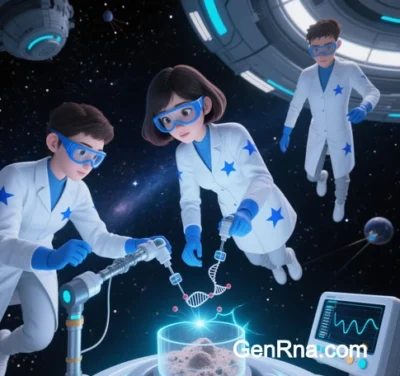 Precision, Innovation, and Clinical Impact
Precision, Innovation, and Clinical Impact
Introduction
Single guide RNA (sgRNA), a cornerstone of CRISPR-Cas9 technology, has revolutionized gene therapy by enabling precise genomic modifications. Its versatility spans monogenic disorders, complex diseases, infectious agents, and cancer. This article explores the expanding therapeutic applications of sgRNA, highlighting breakthroughs in delivery systems, editing strategies, and clinical outcomes.
1. Hematologic Disorders
β-Thalassemia and Sickle Cell Disease
- Mechanism: sgRNA targets the BCL11A enhancer or HBG promoter to reactivate fetal hemoglobin (HbF), compensating for defective adult hemoglobin.
- Delivery: Lipid nanoparticles (LNPs) encapsulating ABE8e-sgRNA mRNA enable in vivo editing of hematopoietic stem cells (HSCs), achieving >80% HbF restoration in preclinical models.
- Outcome: Clinical trials (e.g., CTX001) demonstrate sustained remission and reduced transfusion dependence.
Image suggestion: Schematic of LNP-mediated sgRNA delivery to HSCs, with HbF expression data in erythrocytes.
2. Ocular Diseases
Retinitis Pigmentosa (RP) and Leber Congenital Amaurosis (LCA)
- Mechanism: sgRNA-Cas9 excises dominant mutations (e.g., RHO p.Pro23His) or corrects splicing defects (e.g., CEP290 intronic variants) in photoreceptor cells.
- Delivery: Subretinal AAV injections deliver sgRNA-Cas9 RNPs, rescuing retinal structure and function in murine models.
- Outcome: Improved electroretinogram responses and vision in LCA10 models via CEP290 correction.
Image suggestion: Fluorescence imaging of retinal organoids pre- and post-sgRNA editing, highlighting photoreceptor survival.
3. Neurological Disorders
Huntington’s Disease
- Mechanism: sgRNA targets expanded CAG repeats in the HTT gene, reducing mutant huntingtin protein aggregation.
- Delivery: AAV9 vectors cross the blood-brain barrier, delivering sgRNA-Cas9 to striatal neurons.
- Outcome: Reduced neurotoxicity and motor deficits in rodent models.
4. Metabolic Diseases
Type 2 Diabetes (T2DM)
- Mechanism: sgRNA disrupts DPP-4, enhancing glucagon-like peptide-1 (GLP-1) activity to regulate glucose metabolism.
- Delivery: Lecithin-based nanoliposomes deliver Cas9-sgRNA RNPs to hepatocytes in db/db mice, achieving sustained DPP-4 knockdown.
- Outcome: Normalized blood glucose levels and improved insulin sensitivity comparable to sitagliptin.
Image suggestion: Graph comparing blood glucose levels in sgRNA-treated vs. control T2DM mice.
5. Infectious Diseases
HIV-1 Eradication
- Mechanism: Dual sgRNAs flanking HIV LTR regions excise integrated proviral DNA in latent CD4+ T-cell reservoirs.
- Delivery: Lentiviral vectors enable ex vivo editing of patient-derived T cells, achieving 85% proviral excision.
- Outcome: Undetectable viral rebound in humanized mice post-antiretroviral therapy cessation.
6. Cancer Immunotherapy
CAR-T Cell Engineering
- Mechanism: Multiplexed sgRNAs disrupt immune checkpoints (e.g., PD-1, CTLA-4) to enhance T-cell antitumor activity.
- Delivery: Retron Library Recombineering (RLR) integrates sgRNA libraries into T-cell genomes, enabling high-throughput screening.
- Outcome: Edited CAR-T cells show 75% complete remission rates in B-cell lymphoma trials.
Image suggestion: Heatmap of immune checkpoint gene expression in edited vs. wild-type CAR-T cells.
7. Liver Diseases
Familial Hypercholesterolemia
- Mechanism: Prime editors (PE-sgRNA) correct PCSK9 or LDLR mutations in hepatocytes to lower LDL cholesterol.
- Delivery: AAV8 vectors achieve liver-specific editing, reducing serum LDL by 60% in murine models.
8. Muscular Dystrophies
Duchenne Muscular Dystrophy (DMD)
- Mechanism: sgRNA-mediated exon skipping restores dystrophin reading frames.
- Delivery: LNPs encapsulating sgRNA-Cas9 RNPs outperform antisense oligonucleotides (ASOs) in durability, with therapeutic effects lasting >1 year.
Image suggestion: Western blot of dystrophin expression in sgRNA-treated vs. ASO-treated muscle tissue.
Challenges and Future Directions
1. Delivery Optimization
- Viral vs. Non-Viral Systems: AAVs face cargo limits (<4.7 kb), while LNPs offer transient but scalable delivery.
- Tissue-Specific Targeting: Conjugated nanoparticles (e.g., GalNAc for hepatocytes) enhance precision.
2. Safety and Specificity
- High-Fidelity Editors: HypaCas9 and prime editors reduce off-target effects.
- Real-Time Monitoring: CRISPR-SCAN tracks edits at single-cell resolution.
3. Regulatory and Ethical Considerations
- Germline Editing: Consensus restricts sgRNA-Cas9 to somatic cells.
Emerging Frontiers
- Multiplexed Editing: Arrayed sgRNA libraries target polygenic diseases like Alzheimer’s.
- AI-Driven Design: CRISOT-Opti and DeepCRISPR predict optimal sgRNA sequences using chromatin accessibility data.
Conclusion
sgRNA-based therapies are redefining treatment paradigms across diverse diseases—from hemoglobinopathies to neurodegenerative disorders. Innovations in delivery (LNPs, AAVs), precision (prime editing), and scalability (AI design) continue to address historical limitations. As clinical trials progress, sgRNA promises to unlock cures for previously intractable conditions, heralding a new era of genomic medicine.
Data Source: Publicly available references.
Contact: chuanchuan810@gmail.com




